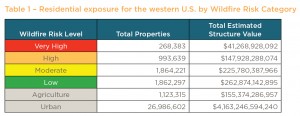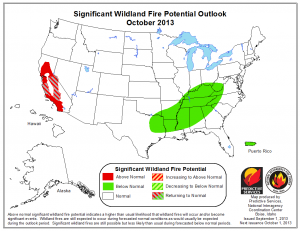Despite a little touch of some wetter and cooler weather, the 2013 wildfire season isn’t over, and the Western states in particular should be prepared for a few more potentially active months.
That’s according to the 2013 CoreLogic Wildfire Hazard Risk Report released on Wednesday, which calls out drought and continued new home construction in the wildland-urban interface for putting at risk billions of dollars’ worth of properties.
The report takes a focus on 13 states in the drought-plagued Western U.S. and breaks down the risks into regions, categories and dollar signs.
“Though this year’s fires haven’t been quite as frequent or widely destructive as the 2012 record-setting season, drought conditions that reached unprecedented levels last year are still plaguing many of the western and plains states and are forecast to persist into late fall,” the report states.
Why such a focus on the West?

In 2012, 87.5 percent of the total acreage lost to wildfire in the coterminous U.S. occurred within these 13 states, the report states.
According to the report, there are more than 1.2 million residential properties in the Western U.S. that are currently located in “High” or “Very High” wildfire-risk categories valued at more than $189 billion – in the “Very High” risk category alone there are roughly 268,000 residences valued at more than $41 billion.
The highest wildfire risk segment in the report – the raking on the scale for this segment is between 81 to 100 – applies to more than 1.5 million homes in the U.S., with total property value at risk estimated to be more than $224 billion.
The number of homes with a score of 61 or above totals 3 million, equating to more than $445 billion in total property value at risk, the report states.
Leading the way in the “Very High” category for total potential exposure to wildfire damage are Colorado ($15.2 billion) and California ($13 billion). Those states were followed by Texas ($6.3 billion), Oregon ($1.7 billion), Arizona ($1.2 million) and New Mexico ($1.18 billion).
California had a $65.46 billion worth of properties in the “High” category, followed by Texas with $46 billion, Colorado with $14.1 billion and Oregon with $8.4 billion.
While the 2013 wildfire season turned out tamer than a year prior, there is still time left for some of these wildfire threats to be realized, said Thomas Jeffery, senior hazard scientist with CoreLogic.
“Ultimately we’re still looking at a tremendously high volume of properties that are at risk there,” Jeffery said.
He added, “According to all estimates we’re still in a fairly significant drought over much of the West.”

The monthly outlook from the National Interagency Fire Center for October calls for “Above Normal” wildland fire potential outlook for September for a large portion of California and parts of Nevada.
In California the wildfire scenario could be compounded by an increasing chance of winds and dry weather being forecast, said Scott Carpenter, a National Weather Service meteorologist.
“The general idea is lately we are looking at least a few offshore wind events through the middle of November,” Carpenter said.
The Southern California area experienced strong winds earlier in the week, and there’s another possibility of winds into next week statewide, according to Carpenter.
“It looks like the early part of next week there’s a chance of a weak offshore wind event,” Carpenter said.
While there has been some precipitation in parts of California, what has fallen has been light, with the heavier rainfall occurring in the mountain areas, Carpenter said.
“It’s not enough to be really a season-ending event,” he said, adding that a big area of Southern California is still the “extreme drought” category.
Of even greater concern than the ongoing drought is a longer-term trend: the increase in the number of properties and the property values as the U.S. real estate market continues its recovery.
“I think we’ve seen a resumption of development,” Jeffery said.
A report from the Commerce Department bears him out.
The department in a report in September said that construction starts on single-family homes rose 7 percent to an annual rate of 628,000 units last month, the highest level in six months.
Much of this new development is going in in the wildland-urban interface, which has a greater chance for homes to be impacted by wildfires, Jeffery said.
“They’re being built in the wildland-urban interface,” he said.
The wildland-urban interface delivers a double-whammy of sorts in terms of potential losses.
There is little room left to build inside urban areas, because they are already over-developed, so much of the building boom is going on in the outskirts, where the wildfire potential is greater.
That means more new, and therefore more pricey, homes are at risk, Jeffery said.
“These are the newest homes,” he said. “They’re more scenic, and people are paying a premium for that. But all things being equal, those things tend to be in the higher risk area as well.”
Unlike other natural hazards, like hurricanes, tornadoes and hail storms, wildfire activity tends to follow a cyclical pattern, according to the report.
So while cooler temperatures and higher levels of rainfall might result in lower levels of wildfire activity for a particular region over the course of a year or two, those conditions also allow for increased vegetation growth and accumulation of fuel that could drive higher wildfire activity in future seasons, the report states.
“This is one hypothesis for why California had relatively less wildfire activity recorded in 2010 and 2011, and then experienced a significant jump in acres burned in 2012,” the report states. “California’s recent Rim Fire supports this hypothesis as yet another fire fueled by drought and historic fire suppression that is contributing to an active wildfire season in 2013. According to U.S. National Park Service Director Jonathan Jarvis, these large fires are likely to continue in the western U.S. into the foreseeable future.”
Despite that, this year brought the Rim Fire, which at more than 257,000 acres is considered the third largest fire in California history, while the Black Forest Fire south of Denver consumed more than 486 structures in June, making it the most destructive fire in Colorado state history.
This fires this year in Colorado, along with the High Park and Waldo Canyon fires last year, now account for the three most destructive fires ever recorded in Colorado, according to the report.
Topics California Catastrophe USA Natural Disasters Wildfire Colorado
Was this article valuable?
Here are more articles you may enjoy.


 Chubb to Acquire MGA Healthy Paws From Aon
Chubb to Acquire MGA Healthy Paws From Aon  Investment Funds File New Suits Over Lighthouse Insurance Collapse in 2022
Investment Funds File New Suits Over Lighthouse Insurance Collapse in 2022  Uncertainty Keeps Prices Up; No Prior-Year Loss Development: Travelers
Uncertainty Keeps Prices Up; No Prior-Year Loss Development: Travelers  FBI Says Chinese Hackers Preparing to Attack US Infrastructure
FBI Says Chinese Hackers Preparing to Attack US Infrastructure 

